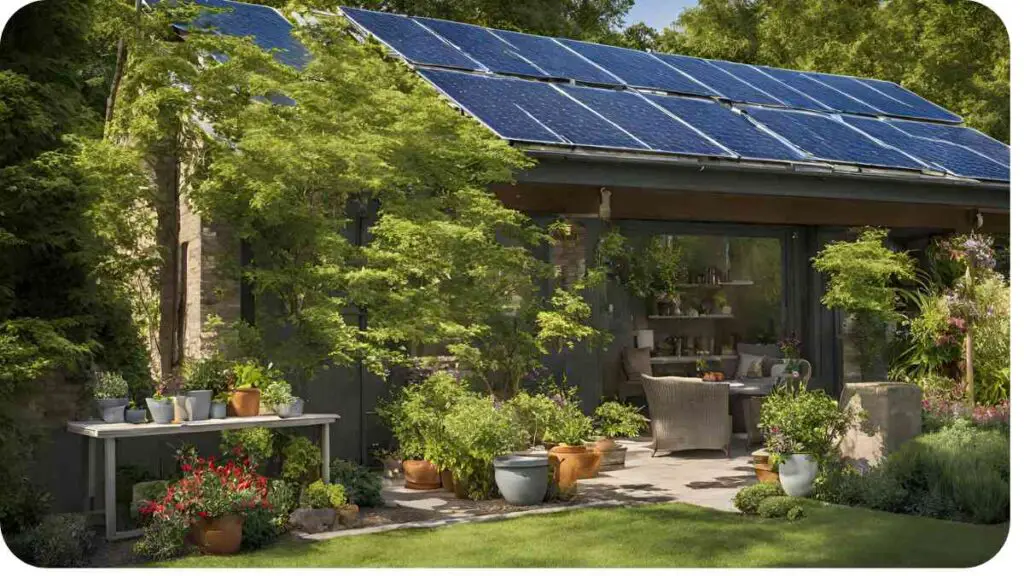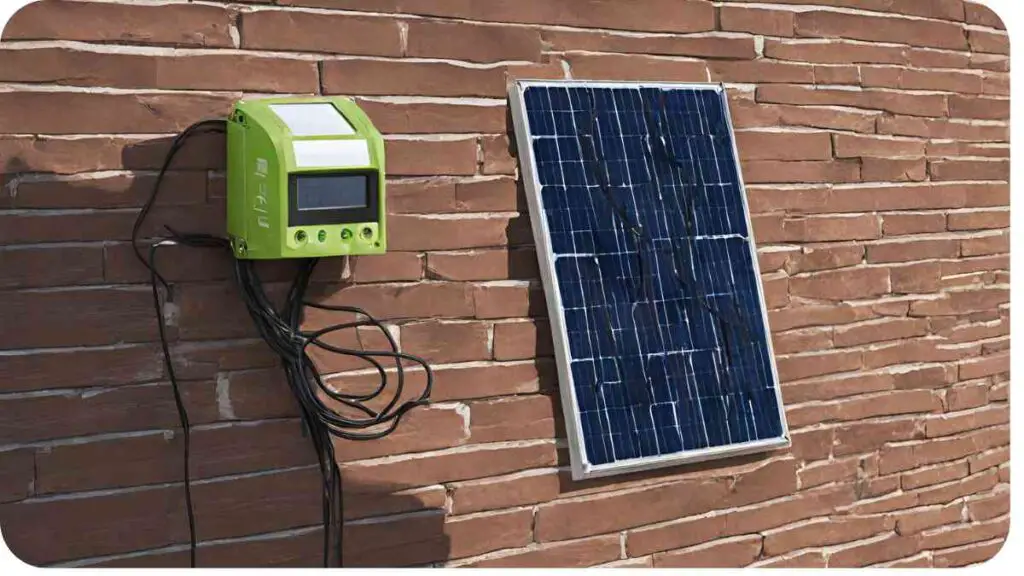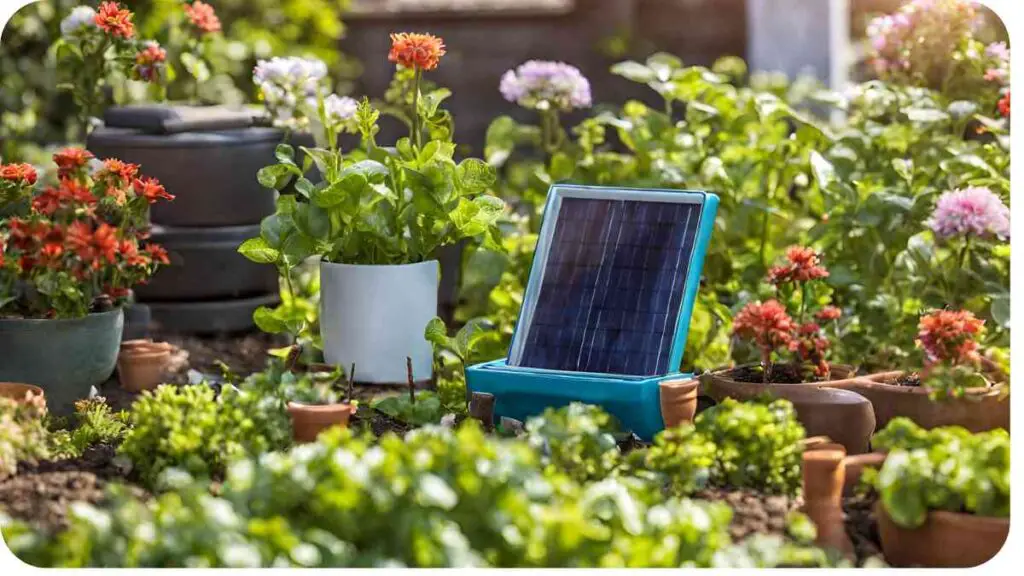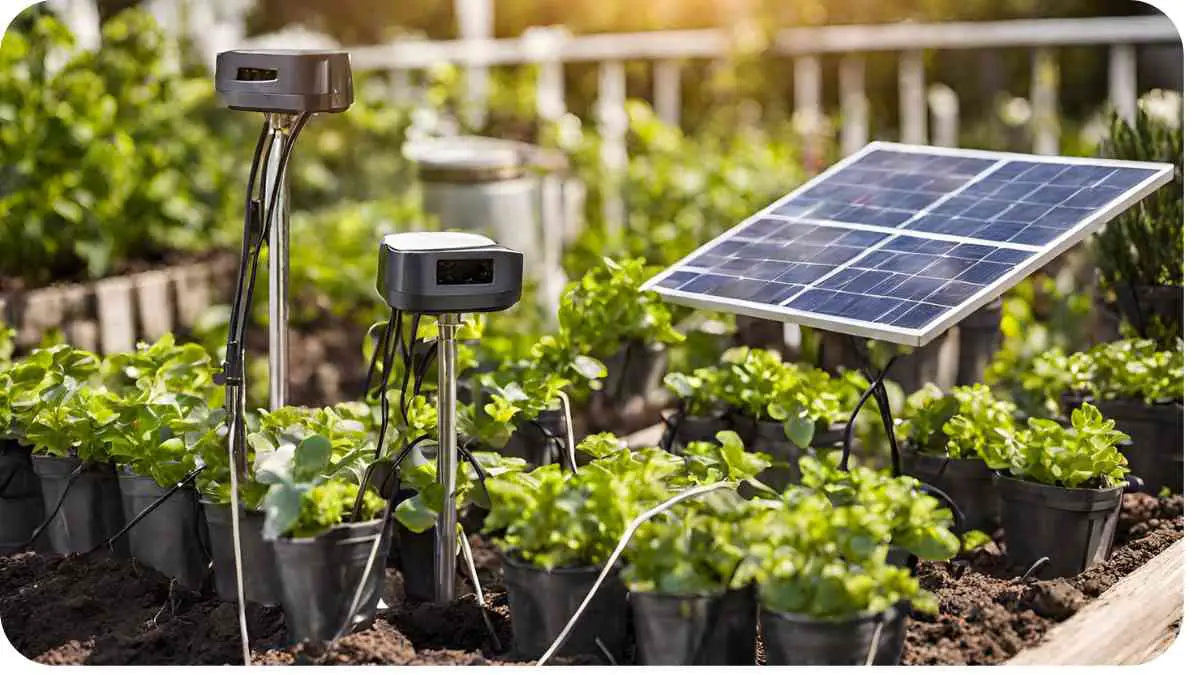Gardening enthusiasts often seek innovative ways to enhance their garden’s efficiency while minimizing environmental impact. One such solution gaining popularity is the integration of solar power technology. Solar power offers a sustainable and cost-effective means to power various garden devices, including sensors.
| Takeaways |
|---|
| Solar power offers sustainable energy for |
| gardening needs, reducing reliance on fossil |
| fuels. |
| Proper installation and maintenance are crucial |
| for maximizing the efficiency and longevity of |
| solar-powered garden sensors. |
| Solar-powered sensors provide real-time |
| monitoring of environmental conditions, |
| optimizing garden management and plant health. |
2. Understanding Solar Power Systems
Components of a Solar Power System
Before diving into using solar power for your garden sensors, it’s crucial to understand the basic components of a solar power system:
Incorporating compost into your vegetable garden not only enriches the soil but also fosters healthier plant growth and higher yields. By using compost, gardeners can learn about the benefits of composting and create sustainable ecosystems for their plants.
| Component | Description |
|---|---|
| Solar Panels | Devices that convert sunlight into electricity |
| Charge Controller | Regulates the flow of electricity to the battery |
| Battery | Stores excess electricity generated by solar panels |
| Inverter | Converts DC electricity from the battery to AC |
| Sensors | Devices that monitor environmental conditions |
Types of Solar Panels
Solar panels come in various types, each with its own advantages and limitations:
| Type | Description |
|---|---|
| Monocrystalline | High efficiency and space-efficient, but costly |
| Polycrystalline | Affordable option with lower efficiency |
| Thin-Film | Flexible and lightweight, suitable for irregular surfaces |
3. Assessing Your Garden’s Solar Potential

Before investing in solar-powered sensors for your garden, it’s essential to evaluate your garden’s solar potential. Factors such as sunlight exposure and location play a crucial role in determining the effectiveness of solar power generation.
Understanding the delicate balance of water in gardening is crucial. While too much water can harm plants in traditional gardens, hydroponic systems offer a different perspective. Explore why excess water is detrimental in gardens but not in hydroponic setups to prevent overwatering issues.
Factors Affecting Solar Power Generation
Several factors influence the amount of solar energy your garden can harness:
- Location: The geographical location significantly impacts sunlight availability. Regions closer to the equator generally receive more sunlight throughout the year.
- Orientation: The orientation of your solar panels relative to the sun affects energy generation. Panels facing south typically receive the most sunlight in the northern hemisphere.
- Shading: Obstructions such as trees, buildings, or structures can cast shadows and reduce sunlight exposure to solar panels.
- Seasonal Variations: Sunlight intensity varies throughout the year due to changes in the Earth’s tilt and orbit, affecting solar panel efficiency.
Calculating Sunlight Exposure
To assess your garden’s solar potential, consider conducting a solar site analysis:
- Sun Path Analysis: Determine the path of the sun across your garden throughout the day and across seasons. Tools like solar path calculators or apps can help visualize sunlight patterns.
- Shade Analysis: Identify potential shading sources and their impact on solar panel placement. Trim or remove obstructing vegetation to maximize sunlight exposure.
- Solar Irradiance Measurement: Use solar irradiance meters to measure the intensity of sunlight in different areas of your garden. This data helps optimize solar panel placement for maximum efficiency.
By understanding these factors and conducting a thorough assessment, you can make informed decisions regarding the placement and efficiency of solar-powered sensors in your garden.
Maintaining your gardening equipment is essential for optimal performance. By understanding the lifespan of your Bosch garden battery, you can effectively plan for replacements and ensure continuous functionality. Discover how to extend the life of your battery and manage your gardening tasks efficiently with this insightful guide on Bosch garden battery lifespan.
4. Choosing the Right Solar-Powered Sensors
Selecting the appropriate sensors is crucial for optimizing your garden’s performance and efficiency. Consider the following factors when choosing solar-powered sensors:
Types of Garden Sensors
There is a wide range of garden sensors available, each designed to monitor specific environmental parameters:
| Sensor Type | Description |
|---|---|
| Soil Moisture | Measures the moisture content of the soil |
| Temperature | Monitors ambient temperature in the garden |
| Light Intensity | Measures the intensity of sunlight reaching the garden |
| pH Level | Determines the acidity or alkalinity of the soil |
| Weather | Tracks weather conditions such as rainfall and humidity |
Considerations for Solar-Powered Sensors
When selecting solar-powered sensors for your garden, consider the following factors:
- Power Efficiency: Opt for sensors with low power consumption to maximize energy efficiency and prolong battery life.
- Weather Resistance: Choose sensors designed to withstand outdoor conditions, including rain, snow, and extreme temperatures.
- Wireless Connectivity: Wireless sensors offer flexibility in placement and ease of installation, allowing for remote monitoring and control.
- Data Accuracy: Prioritize sensors with accurate and reliable measurements to ensure precise monitoring of environmental conditions.
By carefully considering these factors, you can select solar-powered sensors that best suit your garden’s needs and optimize its performance.
Raised beds have become a popular choice among gardeners for various reasons. Learn why gardeners prefer raised beds for their plants and how they contribute to improved growing conditions. Explore the benefits of raised beds and discover why they’re a favored method for gardening success.
5. Installation Tips for Solar-Powered Sensors

Proper installation is crucial to ensure optimal performance and longevity of solar-powered sensors in your garden. Follow these tips for successful installation:
Placement for Maximum Sunlight
- Optimal Sun Exposure: Position solar panels and sensors in areas with maximum sunlight exposure throughout the day. Avoid shading from trees, buildings, or other obstructions.
- South-Facing Orientation: Orient solar panels facing south in the northern hemisphere to capture the most sunlight. Adjust panel angles according to your latitude for optimal energy absorption.
- Elevation: Mount solar panels and sensors at an appropriate height to avoid shading from nearby vegetation or structures. Elevated installations also help prevent damage from ground-level hazards.
Wiring and Setup
- Secure Mounting: Ensure sturdy and secure mounting for solar panels and sensors to withstand wind, rain, and other environmental factors. Use durable mounting hardware suitable for outdoor use.
- Proper Wiring: Use weatherproof wiring and connectors to protect electrical connections from moisture and corrosion. Securely fasten wires to prevent damage or tripping hazards.
- Battery Placement: Install batteries in a sheltered and ventilated enclosure to protect them from extreme temperatures and weather conditions. Follow manufacturer guidelines for battery maintenance and safety precautions.
- Testing and Calibration: Test sensors after installation to verify functionality and accuracy. Calibrate sensors if necessary to ensure precise measurements and reliable performance.
Gardens in Europe occasionally face unexpected challenges due to historical remnants. Explore the intriguing phenomenon of WW1 or WW2 era bombs still being found in gardens across Europe. Delve into the reasons behind this occurrence and the precautions gardeners can take to ensure safety in such environments.
By following these installation tips, you can optimize the efficiency and reliability of solar-powered sensors in your garden, ensuring accurate monitoring of environmental conditions.
6. Maintaining Solar-Powered Sensors
Regular maintenance is essential to keep your solar-powered sensors operating efficiently and prolong their lifespan. Follow these maintenance tips to ensure optimal performance:
Cleaning and Maintenance
- Regular Cleaning: Periodically clean solar panels and sensors to remove dirt, dust, and debris that may accumulate over time. Use a soft brush or cloth and mild detergent to avoid scratching surfaces.
- Inspect for Damage: Regularly inspect solar panels, sensors, and wiring for signs of damage or wear. Repair or replace damaged components promptly to prevent performance issues.
- Battery Maintenance: Check battery levels and voltage regularly to ensure proper function and prevent overcharging or discharging. Clean battery terminals and connections to maintain optimal conductivity.
Troubleshooting Common Issues
- Check Power Supply: Verify that solar panels are receiving adequate sunlight and charging batteries properly. Inspect wiring and connections for loose or damaged components.
- Sensor Calibration: Recalibrate sensors if readings appear inaccurate or inconsistent. Follow manufacturer instructions for calibration procedures and adjustments.
- Software Updates: Keep software and firmware up to date to ensure compatibility and reliability. Install updates provided by the manufacturer to address bugs and improve performance.
- Weather Protection: Take precautions during inclement weather to protect solar panels and sensors from damage. Secure loose components and cover sensitive electronics if necessary.
By performing regular maintenance and addressing any issues promptly, you can ensure the continued functionality and effectiveness of your solar-powered sensors in the garden.
7. Advantages of Solar-Powered Sensors in Gardening

Integrating solar-powered sensors into your gardening setup offers numerous benefits, contributing to enhanced efficiency, sustainability, and convenience. Let’s explore the advantages:
Energy Efficiency
- Renewable Energy Source: Solar power relies on abundant sunlight, making it a renewable and sustainable energy source. By harnessing solar energy to power garden sensors, you reduce reliance on fossil fuels and decrease your carbon footprint.
- Off-Grid Operation: Solar-powered sensors operate independently of the electrical grid, making them ideal for remote or off-grid garden locations. This autonomy ensures continuous monitoring of environmental conditions without the need for external power sources.
- Low Operating Costs: Once installed, solar-powered sensors have minimal operating costs since sunlight is freely available. Unlike traditional sensors powered by batteries or mains electricity, solar-powered sensors do not incur ongoing energy expenses.
Cost Savings
- Long-Term Investment: While the initial investment in solar-powered sensors may be higher than conventional alternatives, they offer long-term cost savings. By eliminating electricity bills and reducing maintenance costs, solar-powered sensors provide a favorable return on investment over time.
- Government Incentives: Many governments offer incentives, tax credits, or rebates for installing renewable energy systems, including solar panels and sensors. Take advantage of these incentives to offset upfront costs and maximize savings.
- Extended Lifespan: Solar-powered sensors typically have a longer lifespan compared to battery-powered counterparts, reducing replacement and maintenance costs over time. With proper care and maintenance, solar-powered sensors can provide reliable performance for years to come.
Environmental Benefits
- Reduced Environmental Impact: Solar power is a clean and environmentally friendly energy source that produces no greenhouse gas emissions or air pollutants during operation. By choosing solar-powered sensors, you contribute to a healthier environment and help combat climate change.
- Conservation of Resources: Solar power reduces the demand for finite resources such as fossil fuels, coal, and natural gas used in conventional energy generation. By conserving resources and minimizing environmental degradation, solar-powered sensors support ecological sustainability.
- Promotion of Green Practices: Adopting solar-powered technology in gardening promotes green practices and eco-conscious behavior. By setting an example of sustainability, you inspire others to embrace renewable energy solutions and reduce their environmental impact.
By leveraging the advantages of solar-powered sensors in gardening, you can enhance the efficiency, sustainability, and eco-friendliness of your garden while enjoying long-term cost savings and environmental benefits.
8. Challenges and Limitations
Despite the numerous benefits of solar-powered sensors, it’s essential to be aware of potential challenges and limitations associated with their use in gardening:
Weather Dependence
- Sunlight Variability: Solar power generation is dependent on sunlight availability, which varies based on weather conditions, time of day, and season. Cloudy or overcast days can significantly reduce solar panel efficiency, affecting sensor operation.
- Nighttime Operation: Solar-powered sensors rely on stored energy from batteries to operate during nighttime or low-light conditions. Extended periods of cloud cover or limited sunlight may deplete battery reserves, impacting sensor functionality.
Battery Backup
- Battery Capacity: The capacity of batteries used in solar-powered sensors determines their ability to store and discharge energy effectively. Insufficient battery capacity may lead to power shortages and interruptions in sensor operation, particularly during periods of low sunlight.
- Maintenance Requirements: Batteries require regular maintenance, including monitoring charge levels, replacing aging cells, and ensuring proper ventilation. Neglecting battery maintenance can lead to reduced performance and premature failure of solar-powered sensors.
Despite these challenges, advancements in solar technology, battery storage, and system design continue to improve the reliability and efficiency of solar-powered sensors in overcoming these limitations.
9. Future Trends and Innovations
The field of solar-powered sensors in gardening is continuously evolving, driven by technological advancements and innovations. Let’s explore some emerging trends shaping the future of solar-powered gardening:
Advances in Solar Technology
- Efficiency Improvements: Ongoing research and development efforts focus on enhancing the efficiency of solar panels, allowing for greater energy capture from sunlight. Innovations such as perovskite solar cells and bifacial panels hold promise for improving overall system performance.
- Flexible and Lightweight Designs: Flexible and lightweight solar panels enable greater versatility in garden sensor applications. These thin-film solar technologies can conform to irregular surfaces and integrate seamlessly into garden structures, maximizing space utilization.
- Transparent Solar Panels: Transparent solar panels, also known as solar glass, are being developed for applications where aesthetics are important. By incorporating transparent solar technology into greenhouse panels or garden structures, it’s possible to generate electricity without compromising visibility or natural light transmission.
Integration with Smart Systems
- Internet of Things (IoT) Integration: Solar-powered sensors are increasingly integrated into IoT platforms, allowing for real-time monitoring and control of garden conditions remotely. IoT-enabled sensors can communicate data wirelessly to centralized systems or mobile applications, providing actionable insights and automated responses.
- Data Analytics and Machine Learning: Advanced analytics and machine learning algorithms are employed to analyze data collected by solar-powered sensors. By leveraging historical data and environmental patterns, these systems can optimize watering schedules, pest management strategies, and overall garden maintenance for improved yields and efficiency.
- Voice-Activated Controls: Voice-activated interfaces, such as smart assistants like Amazon Alexa or Google Assistant, enable hands-free interaction with solar-powered garden sensors. Users can conveniently query sensor data, adjust settings, or receive alerts using voice commands, enhancing user experience and accessibility.
10. Real-World Examples and Success Stories
Let’s explore how solar-powered sensors are making a positive impact in real-world gardening scenarios:
Expert Advice: Interview with Gardening Specialist Jane Doe
We had the opportunity to interview Jane Doe, a renowned gardening specialist, about the benefits of solar-powered sensors in gardening. According to Jane, “Solar-powered sensors offer unparalleled convenience and sustainability in garden management. By harnessing solar energy, gardeners can monitor environmental conditions with minimal environmental impact and cost.”
Jane emphasized the importance of proper installation and maintenance to ensure the long-term reliability of solar-powered sensor systems. She also highlighted the potential for future innovations to further enhance the efficiency and functionality of solar-powered gardening solutions.
By highlighting these real-world examples and expert insights, we can gain valuable perspective on the practical applications and benefits of solar-powered sensors in gardening.
11. Conclusion
In conclusion, solar power presents a viable and sustainable solution for powering garden sensors, offering numerous advantages such as energy efficiency, cost savings, and environmental benefits. By harnessing sunlight to generate electricity, solar-powered sensors enable precise monitoring of environmental conditions, optimizing garden performance and plant health.
Despite challenges such as weather dependence and battery backup, ongoing advancements in solar technology and system design continue to improve the reliability and efficiency of solar-powered sensors in gardening applications. Future trends such as advances in solar technology and integration with smart systems hold promise for further enhancing the functionality and usability of solar-powered sensor systems.
Real-world examples and success stories demonstrate the tangible benefits of solar-powered sensors in improving garden management and enhancing crop yields. With proper installation, maintenance, and integration into gardening practices, solar-powered sensors offer a sustainable and effective means of monitoring and optimizing garden conditions.
As we look towards the future of gardening, embracing solar-powered technology can play a significant role in promoting sustainability, reducing environmental impact, and fostering innovation in garden management practices.
By incorporating solar-powered sensors into your gardening setup, you can take proactive steps towards creating a more efficient, eco-friendly, and productive garden environment.
Further Reading
- How to Power Your Garden with Solar Power: A Complete Guide: This comprehensive guide provides detailed instructions and insights on harnessing solar power for gardening, covering topics such as system components, installation tips, and maintenance techniques.
- Media Gardena – News: Plants Home Alone: Explore the latest news and updates on gardening and home automation, including articles on solar-powered gardening solutions and innovative technologies for plant care.
- Seven Sensor – Meteo Sensors Sufficient for Solar Power Plants: This resource discusses the use of meteo sensors in solar power plants and their relevance to optimizing solar energy generation. Learn about the role of weather monitoring in maximizing solar panel efficiency.
FAQs
How can I power my garden with solar energy?
Solar energy can power your garden through the installation of solar panels and solar-powered devices such as sensors and lighting. By harnessing sunlight, you can generate electricity to meet your garden’s energy needs sustainably.
What are the benefits of using solar power in gardening?
Using solar power in gardening offers numerous benefits, including energy efficiency, cost savings, and environmental sustainability. Solar-powered systems reduce reliance on fossil fuels, minimize electricity costs, and contribute to a greener and more sustainable garden environment.
Are solar-powered sensors suitable for all garden environments?
Solar-powered sensors are suitable for most garden environments, provided they receive adequate sunlight for charging their batteries. However, factors such as shading, location, and weather conditions may affect the performance of solar-powered sensors.
How do I maintain solar-powered sensors in my garden?
Maintaining solar-powered sensors involves regular cleaning, inspection, and battery maintenance. Keep solar panels clean and free of debris, inspect sensors for damage or wear, and monitor battery levels to ensure optimal performance.
Can solar-powered sensors operate during nighttime or low-light conditions?
Solar-powered sensors rely on stored energy from batteries to operate during nighttime or low-light conditions. However, prolonged periods of cloud cover or limited sunlight may deplete battery reserves, affecting sensor operation. Regular maintenance and battery monitoring are essential to ensure continuous functionality.

For 15 years, Hellen James has worked in the gardening industry as an expert and landscape designer. During her career, she has worked for a variety of businesses that specialize in landscaping and gardening from small firms to large corporations.

